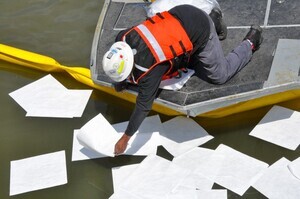Marine Spill Response on BC’s Coast: What Happens, and How to Be Ready
July 3rd 2025

Marine spills — whether from vessels, marinas, or dockside operations — can happen in any port city along the British Columbia coast. From Victoria and Vancouver to Kitimat and Prince Rupert, knowing how a marine spill response works is essential for anyone operating on or near the water.
While federally certified response organizations like the Western Canada Marine Response Corporation (WCMRC) handle large-scale incidents, the responsibility to act quickly in the initial moments often falls on the vessel operator, port manager, or facility staff.
That’s where West Coast Spill Supplies comes in. Based on Vancouver Island, we supply the equipment that marine professionals rely on to be prepared — from absorbent booms and spill kits to PPE and spill containment equipment & tools. We help organizations meet their regulatory obligations and respond effectively before emergency crews are needed or before they arrive.
Being ready isn’t optional — it’s part of operating responsibly on BC’s coast. Here’s what to expect during a marine spill response, and how to prepare with the right supplies on hand.
How Marine Spill Response Works in BC
In Canada, marine oil spills in navigable waters fall under federal jurisdiction. On the West Coast, WCMRC is the designated response organization, certified by Transport Canada to respond to marine spills from vessels and oil-handling facilities.
They maintain response bases across the region, including in Vancouver, Nanaimo, Sidney, Port Alberni, Beecher Bay / Sooke, and Prince Rupert. When a report is filed, their team mobilizes containment and recovery equipment by vessel, air, or road, depending on the location.
But even with their capabilities, there’s one critical detail marine operators should understand:
- The first response to a spill is always your responsibility.
Federal regulations require that vessels and facilities have the means to respond immediately to pollution incidents. This includes equipment on-site or onboard to contain and mitigate a spill while waiting for WCMRC or the Canadian Coast Guard to arrive.
Your Role Before WCMRC Arrives
A marine spill rarely begins as a full-scale disaster. It often starts small — a burst hydraulic line, a bilge discharge, or a fueling mistake. In places like Campbell River, Port McNeill, or Tofino, where tides move quickly and response bases may be hours away, those first few minutes matter.
Having spill kits, absorbent booms, pads, and disposal bags on hand allows operators to act immediately — containing the spill, protecting the environment, and minimizing legal or reputational consequences.
At West Coast Spill Supply, we help customers meet those requirements. Whether you're outfitting a fleet of vessels, managing a port terminal, or operating a remote coastal worksite, we supply the tools you need to be ready.
Why Port Cities Still Need On-Site Supplies
Even with a response plan and a WCMRC arrangement in place, local operators must be equipped to handle a spill the moment it happens. This is especially important in smaller or remote ports, where geography and weather can affect how quickly a response team can reach the site.
That’s why our customers in Port Hardy, Bella Bella, Ucluelet, and along the Central Coast stock up on marine spill response gear in advance. By having the right products in the right place, they’re able to contain small spills before they spread — and demonstrate due diligence in the eyes of regulators.
What to Have On Hand
For most marine operations, a spill kit is the foundation — but it should be matched to your risk level, vessel type, and operating environment. Here are the core components we recommend for any BC marine site:
- Oil-only sorbent pads and rolls
- Absorbent booms & Containment booms for on-water containment
- Spill response bags or kits (vessel-sized or facility-sized)
- Personal protective equipment (PPE)
- Leak-sealing putty or plugs for onboard pipe leaks
- Disposal bags and containers for used sorbents
- Emergency instructions and labels for reporting procedures
We also carry specialized equipment for bulk fuel transfers, floating docks, and remote marine operations. If you're unsure what you need, we're happy to recommend products based on your operation size and location.
BC Ports Are Diverse — So Are the Risks
No two coastal cities face exactly the same marine spill risk. That’s why a one-size-fits-all approach doesn’t work for spill preparedness. Here's a quick snapshot of how needs vary by location:
- Vancouver: Busy commercial shipping, fuel transfers, and marina activity increase the risk of both small and large spills.
- Nanaimo & Campbell River: Ferry terminals and fishing fleets need compact, vessel-ready spill kits.
- Prince Rupert & Kitimat: Bulk cargo and heavy marine traffic demand larger-scale onsite containment.
- Ucluelet, Port Hardy & Bella Bella: Remote and weather-exposed, with limited access to immediate outside support — preparedness is essential.
No matter where you operate, having the right spill response supplies on hand allows you to meet your environmental obligations and reduce risk to the marine environment.
Coastal Support from a Local Supplier
At West Coast Spill Supply, we’re based right here on Vancouver Island, and we know BC’s coastline — from the Gulf Islands to Haida Gwaii. We ship spill response equipment across the province and work with port authorities, marine contractors, fisheries, and vessel operators who take preparedness seriously.
A marine spill can happen anywhere. The question is: will you be ready when it does?
Need help choosing the right marine spill supplies for your location?
Contact us today — we’re here to help you prepare.
